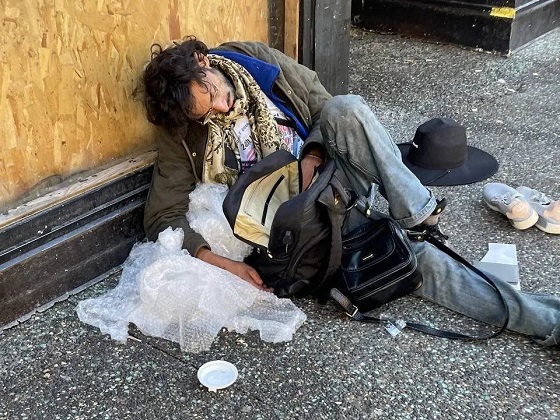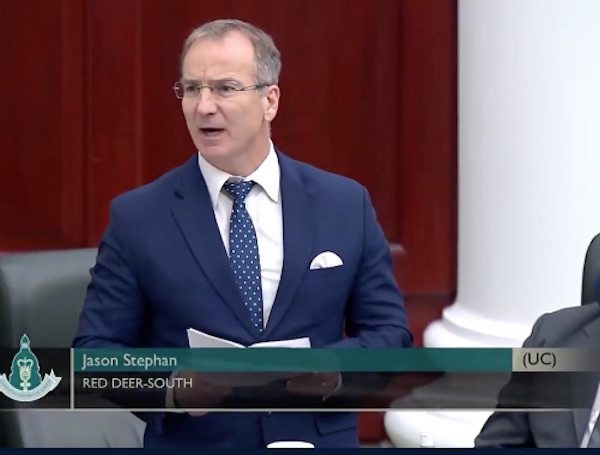Addictions
Alberta closing Red Deer’s only overdose prevention site in favor of recovery model

Alberta’s Minister of Mental Health and Addiction, Dan Williams, at the Alberta Legislature in Edmonton on Sept. 11 2024. [Photo credit: Alexandra Keeler]
Alberta’s Minister of Mental Health and Addiction explains the shift from overdose prevention to recovery amid community concerns
On Sept. 23, Alberta announced the city of Red Deer would be closing the community’s only overdose prevention site by spring 2025. The closure will mark the first time an Alberta community completely eliminates its supervised consumption services.
The decision to close the site was taken by the city — not the province. But it aligns with Alberta’s decision to prioritize recovery-focused approaches to addiction and mental health over harm-reduction strategies.
“The whole idea of the Alberta Recovery Model is that unless you create off-ramps [from] addiction, you’re barreling ahead towards a brick wall, and that’s going to be devastating,” Alberta Minister of Mental Health and Addiction Dan Williams told Canadian Affairs in an interview in September.
However, the closure — which parallels similar moves by other provinces — has sparked debate over whether recovery-oriented models adequately meet the needs of at-risk populations.
The Alberta Recovery Model
The Alberta Recovery Model, which was first introduced by Alberta’s UCP government in November 2023, emphasizes prevention, early intervention, treatment and recovery.
It is informed by recommendations from Alberta’s Mental Health and Addiction Advisory Council and research from the Stanford Lancet Commission on the North American Opioid Crisis.
“Alberta, in our continuum of care, has everything from low entry, low barriers, and zero cost [for] detox, to treatment, to virtual opioid dependency, to outreach teams working with shelters,” said Williams.
Williams said that Alberta intends to continue funding safe consumption sites as short-term harm-reduction measures. But it views them as temporary components in the continuum of care.
This is not without controversy.
At the Feb. 15 Red Deer council meeting where councillors voted 5-2 to close the city’s safe consumption site, some councillors noted that safe consumption sites play an essential role in the continuum of care.
“Each individual is at a different stage of addiction … the overdose prevention site does play a role in the treatment spectrum,” said Coun. Dianne Wyntjes, who voted against the closure.
While Red Deer is home to Alberta’s first provincially funded addiction treatment facility, Wyntjes noted there had been reports within the community of the facility lacking capacity to meet demand.
She pointed to Lethbridge’s experience in 2020, where overdose deaths spiked after its consumption site was replaced with mobile services.
The Ontario government’s recent decision to close 10 safe consumption sites located near schools and daycares has prompted similar concerns.
In August, Ontario Health Minister Sylvia Jones told reporters that the province plans to “very quickly” replace the closed sites with Homelessness and Addiction Recovery Treatment (HART) hubs that prioritize community safety, treatment and recovery. But critics — including site workers, NDP MPPs and harm-reduction advocates — have warned these shutdowns will lead to an increase in fatal overdoses.
It is possible that Alberta, Ontario and other jurisdictions will make other moves in tandem in the coming months and years.
In April, Alberta announced it was partnering with Ontario and Saskatchewan to build recovery-focused care systems. The partnerships include sharing of best practices and advocating for recovery-focused policies and investments at the federal level.
Our content is always free – but if you want to help us commission more high-quality journalism, consider getting a voluntary paid subscription.
‘Mandatory treatment’
Another controversial component of Alberta — and other provinces’ — recovery-oriented strategy is involuntary care.
The UCP government has said it plans to introduce “compassionate intervention” legislation next year that will enable family members, doctors or police officers to seek court orders mandating treatment for individuals with substance use disorders who pose a risk to themselves or others.
“If someone is a danger to themselves or others in the most extreme circumstances because of their addiction, then we as a society have an obligation to intervene, and that might include mandatory treatment,” said Williams.
Critics have raised concerns about increasing reliance on involuntary care options.
“Over the last two decades, there has been a dramatic increase in reliance on involuntary services [such as psychiatric admissions and treatment orders], while voluntary services have not kept up with demand,” the B.C. division of the Canadian Mental Health Association said in a Sept. 18 statement published on their website.
The statement followed an announcement by B.C. Premier David Eby — who was recently reelected — to expand involuntary care in that province.
Research from Yale University’s School of Public Health indicates involuntary interventions for substance use are generally no more effective than voluntary treatment, and can in some cases cause more harm than good. The research notes that “involuntary centers often serve as venues for abuse.”
A 2023 McMaster University study that synthesized the research on involuntary treatment from international jurisdictions similarly found inconclusive outcomes. It recommended expanding voluntary care options to minimize reliance on involuntary measures.
Williams emphasized that the province’s involuntary care legislation would target “a very small group of people for whom all else has failed … those at the far end of the addiction spectrum with very serious and devastating addictions.”
‘Off-ramps from addiction’
Over the past six years, Alberta has incrementally increased its mental health and addiction budget from an initial $50 million to a cumulative total of $1.5 billion.
The funding boost has enabled Alberta to eliminate a $40 daily user fee for some detox and recovery services, add 10,000 publicly funded addiction treatment spaces, and expand access to its Virtual Opioid Dependency Program, which offers same-day access to life-saving medications.
To support addiction prevention, Williams said Alberta is expanding CASA Classrooms in schools. These offer mental health support and therapy to Grade 4-12 students who have ongoing mental health challenges, and equip school staff and caregivers to support these students.
“Mental health and addiction needs to be as connected to the emergency room as it is to the classroom,” Williams said. “We need to be able to understand low-acuity chronic mental health challenges as they begin to manifest [in the community].”
The province is also in the process of establishing 11 residential recovery communities across the province. These centres provide free, extended treatment averaging four months — which is longer than most recovery programs.
Oct. 23 marked the one-year anniversary of one such centre, the Lethbridge Recovery Community. The $19-million, 50-bed facility served more than 110 clients in its first year and expects to serve about 200 individuals in 2025.
“I’m coming to see that entering treatment is only the start,” said Sean P., a client of Lethbridge Recovery Community, in a government press release celebrating the anniversary.
“With the support of the staff and the community here, I’m beginning to face my past and make real changes. Recovery is giving me the tools I need for this journey, and I’m genuinely excited to keep growing and moving forward with their help.”
Our content is always free – but if you want to help us commission more high-quality journalism, consider getting a voluntary paid subscription.
Addictions
Manitoba Is Doubling Down On A Failed Drug Policy

From the Frontier Centre for Public Policy
Manitoba is choosing to expand the same drug policy model that other provinces are abandoning, policies that normalize addiction while sidelining treatment, recovery, and public safety.
The New Democrat premier of British Columbia, David Eby, stood before reporters last spring and called his government’s decision to permit public drug use in certain spaces a failure.
The policy was part of the broader “harm reduction” strategy meant to address overdose deaths. Instead, it had stirred public anger, increased street disorder and had helped neither users nor the communities that host them. “We do not accept street disorder that makes communities feel unsafe,” Eby said. The province scrapped the plan.
In Alberta, the Conservative government began shutting down safer-supply prescribing due to concerns about drug diversion and misuse. The belief that more opioids can resolve the opioid crisis is losing credibility.
Ontario Progressive Conservatives are moving away from harm reduction by shutting down supervised consumption sites near schools and limiting safer-supply prescribing. Federal funding for programs is decreasing, and the province is shifting its focus to treatment models, even though not all sites are yet closed.
Yet amid these non-partisan reversals, Manitoba’s government has announced its intention to open a supervised drug-use site in Winnipeg. Premier Wab Kinew said, “We have too many Manitobans dying from overdose.” True. But it does not follow that repeating failed approaches will yield different results.
Reversing these failed policies is not a rejection of compassion. It is a recognition that good intentions do not produce good outcomes. Vancouver and Toronto have hosted supervised drug-use sites for years. The death toll keeps rising. Drug deaths in British Columbia topped 2,500 in 2023, even with the most expansive harm reduction infrastructure in the country. A peer-reviewed study published this year found that hospitalizations from opioid poisoning rose after B.C.’s safer-supply policy was implemented. Emergency department visits increased by more than three cases per 100,000 population, with no corresponding drop in fatal overdoses.
And the problem persists day to day. Paramedics in B.C. responded to nearly 4,000 overdose calls in July 2024 alone. The monthly call volume has exceeded 3,000 almost every month this year. These are signs of crisis management without a path to recovery.
There are consequences beyond public health. These policies change the character of neighbourhoods. Businesses suffer. Residents feel unsafe. And most tragically, the person using drugs is offered little more than a cot, a nurse and a quiet signal to continue. Real help, like treatment, housing and purpose, remains out of reach.
Somewhere along the way, bureaucracies stopped asking what recovery looks like. They have settled for managing human decline. They call it compassion. But it is really surrender, wrapped in medical language.
Harm reduction had its time. It made sense when it first emerged, during the AIDS crisis, when dirty needles spread HIV. Back then, the goal was to stop a deadly virus. Today, that purpose has been lost.
When policy drifts into ideology, reality becomes an afterthought. Underneath today’s approach is the belief that drug use is inevitable, that people cannot change, that liberty means letting others fade away quietly. These ideas do not reflect science. They do not reflect hope. They reflect despair. They reflect a politics that prioritizes the appearance of compassion over effectiveness.
What Manitoba needs is treatment access that meets the scale of the problem. That means detox beds, recovery homes and long-term care focused on restoring lives. These may not generate the desired headlines, but they work. They are demanding. They are slow. And they offer respect to the person behind the addiction.
There are no shortcuts. No policy will undo decades of pain overnight. But a policy that keeps people stuck using is not mercy. It is maintenance with no way out.
A government that believes in its people should not copy failure.
Marco Navarro-Genie is vice-president of research at the Frontier Centre for Public Policy and co-author, with Barry Cooper, of Canada’s COVID: The Story of a Pandemic Moral Panic (2023).
Addictions
The Death We Manage, the Life We Forget

 Marco Navarro-Génie
Marco Navarro-Génie
Our culture has lost the plot about what it means to live.
Reading that Manitoba is bringing supervised consumption to Winnipeg got me thinking.
Walk through just about any major Canadian city, and you will see them. Figures bent forward at seemingly impossible angles, swaying in the characteristic “fentanyl fold,” suspended between consciousness and oblivion. They resemble the zombies of fiction: bodies that move through space without agency, awareness, or connection to the world around them. We think of zombies as the walking dead. Health workers and bureaucrats reverse their overdoses, send them back to the street, and call it saving lives.
At the same time, Canada offers medical assistance in dying to a woman who cited chemical sensitivities and the inability to find housing. It has been offered to veterans who asked for support and were met instead with an option for death. We fight to prevent one form of death while facilitating another. The contradiction is not accidental. It reveals something about the people involved and the funding behind it. That’s our culture. Us. It appears to me that our culture no longer knows what life is.
Ask any politician or program bureaucrat, and you will hear them explain, in the dry language of bureaucracy, that the twin approach to what they call harm reduction and medical assistance in dying (MAiD) rests on the shared premise of what they believe to be compassion. They think they respect autonomy, prevent suffering, and keep people alive when possible. It sounds humane. It is, in practice, incoherent. Bear with me for a moment.
The medical establishment administers naloxone to reverse overdoses in people who spend as many as twenty hours a day unconscious. They live without meaningful relationships or memories, with little capacity for choice. The technocrats and politicians call that saving lives. They also provide assisted death to people whose suffering comes primarily from poverty, isolation, or lack of housing. There was a time when these factors could, at least in theory, be addressed so that the terminal decision did not need to be made. Now they are accepted as grounds for ending life.
But why is one preference final and the other treated as an error to correct? That question reflects the deeper disorientation.
We saw the same thing during COVID. Elderly people in care homes were left without touch, family, or comfort for days. They often died in solitude, their dementia accelerated by isolation. And those conditions were inflicted upon them in the name of saving their lives. The “system” measured success in preventing infections, not in preserving connections. Je me souviens. Or we should.
There is a pattern here. We have reduced the idea of saving lives to keeping bodies breathing, while ignoring what makes a life human: agency, meaning, development, and relationship. And in doing so, we begin to define life as mere biological persistence. But to define life by the capacity to breathe and perform basic functions is to place ourselves on the same footing as the non-human animals. It is to say, tacitly, that there is no fundamental distinction between a person and a creature. That, too, is a form of forgetting.
To be clear, the argument here is not that hopeless drug users should be administered MAiD. Instead, it is essential to recognize that the intellectual framework behind harm reduction and MAiD must be taken seriously, as it rests on some rationally defensible claims. In an age where most arguments are emotive and unexamined, the mildly logical has become strangely compelling.
It begins with the idea of autonomy. We cannot force others to live by our values. Every person must decide what makes life worth living. To insist otherwise is paternalism.
Then comes pragmatic compassion. People will use drugs whether we approve or not. People will find their lives unbearable, whether we acknowledge it or not. We can support them or moralize while they die.
There is also an emphasis on subjective experience. No one knows another’s pain. If someone says their suffering is intolerable, we are in no position to deny it, they say. If a user would rather face opioids than withdrawal and despair, are we entitled to interfere?
Finally, the comparison to medical ethics: we do not withhold insulin from diabetics who continue to eat poorly. We do not deny cancer treatment to smokers. Medicine responds to suffering, even when the patient has contributed to their condition. Harm reduction, they argue, simply applies that principle to addiction.
These arguments produced tangible benefits, they argue. Needle exchanges reduced HIV transmission. Naloxone kits prevented deaths. Safe injection sites meant fewer people dying alone. MAiD brought relief to those in agony. These were not trivial outcomes. I am aware.
Yet when we look more closely, the very logic that underlies these policies also exposes their fatal limitations.
Addiction undermines choice. It hijacks the brain’s ability to reason, compare, and choose. A person deep in addiction is not selecting between alternatives like someone choosing coffee or tea. The structure of choice, the human will, itself is broken. The addiction decides before the person does. St Augustine knew this. Dostoyevsky knew it too.
And for the empirically minded, the research supports this. In British Columbia, where the “safe supply” model was pioneered, some addiction physicians now say the policy is failing. Worse, it may be creating new opioid dependencies in people who were not previously addicted. A study earlier this year found that opioid‑related hospitalizations increased by about 33 percent, compared with pre‑policy rates. With the later addition of a drug-possession decriminalization policy, hospitalizations rose even more (overall, a 58 percent increase compared to before SOS’s implementation). The study concluded that neither safer supply nor decriminalization was associated with a statistically significant reduction in overdose deaths. This is not freedom. It is a new form of bondage, meticulously paved by official compassion.
Despair disguises itself as autonomy, especially in a spiritually unmoored culture that no longer knows how to cope with suffering. A person requesting assisted death because of chronic, untreatable pain may appear lucid and composed, but lucidity is not the same as wisdom. One can reason clearly from false premises. If life is reduced to the absence of pain and the preservation of comfort, then the presence of suffering will seem like failure, and death will appear rational. But that is not a genuine choice because it is based on a misapprehension of what life is. All life entails pain. Some of it is redemptive. Some of it is endured. But it does not follow that the presence of suffering justifies the conclusion of life.
Someone turning to drugs because of homelessness, abandonment, or despair is often in an even deeper eclipse of the will. Here, there is not even the appearance of deliberation, only the reach for numbness in the absence of meaning. What looks like a decision is the residue of collapse. We are not witnessing two forms of autonomy, one clearer than the other. We are witnessing the breakdown of autonomy in various forms, and pretending that it is freedom.
Biological survival is not life. When we maintain someone in a state of near-constant unconsciousness, with no relationships, no capacity for flourishing, we are not preserving life. We are preserving a body. The person may already be gone. To define life as nothing more than breathing and performing bodily functions is to deny what makes us human. It reduces us to the level of non-human creatures, sentient, perhaps, but without reason, memory, moral reflection, or the possibility of transcendence. It tacitly advances the view that there is no essential difference between a person and a critter, so long as both breathe and respond to some stimuli.
Governments do these things to keep ballooning overdosing deaths down, preferring to maintain drugs users among the undead instead. That reminds me of how the Mexican government hardly moves a finger to find the disappeared, 100,000 strong of lately. For as long ss they’re disappeared, they choose not to count them as homicides, and they feel justified in ignoring the causes of all the killing around them.
Some choices are nefarious. Some choices deserve challenge. Not all autonomous acts are equal. The decision to continue living with pain, or to fight addiction, requires agency. The decision to surrender to despair may signal the absence of it. To say all choices are equal is to empty the word autonomy of meaning.
This reflects a dangerously thin view of the human person that permeates our present. What we now call “harm” is only death or physical pain. What we call good is whatever someone prefers. But people are more than collections of wants.
We should have learned this by now. In Alberta, safer supply prescribing was effectively banned in 2022. Officials cited diversion and lack of measurable improvement. We are forcing some people into treatment because we recognize the impairment of judgement in addiction.
In British Columbia, public drug use was quietly re-criminalized after communities rebelled. This was an admission of policy failure. “Keeping people safe is our highest priority,” Premier David Eby said. Yet safe supply remains. In 2023, the province recorded more than 2,500 overdose deaths. Paramedics continue to respond to thousands of overdose calls each month. This is not success. It is a managed collapse.
Meanwhile, Manitoba is preparing to open its own supervised drug-use site. Premier Wab Kinew said, “We have too many Manitobans dying from overdose… so this is one tool we can use.” That may be so. However, it is a tool that others are beginning to set aside. It is a largely discredited tool. Sadly, in the self-professed age of “Reconciliation” with Aboriginal Canadians, Aboricompassionadians are disproportionately affected by these discredited policies.
The Manitoba example illustrates the broader problem, despite damning evidence. Instead of asking what helps people live, we ask whether they gave consent. We do not ask whether they were capable of it. We ask whether they avoided death. We do not ask whether they found purpose.
We are not asking what might lead someone out of addiction. We are not asking what they need to flourish. We ask only what we can do to prevent them from dying in the short term. And when that becomes impossible, technocracy offers them death in a more organized form, cleanly approved by government. That’s compasson.
The deeper problem is not policy incoherence. It is the cultural despair that skates on the thin ice of meaninglessness. These policies make sense only in a culture that has already decided life is not worth too much. What matters is state endorsement and how it’s done .
It is more cost-effective to distribute naloxone than to construct long-term recovery homes. It is easier to train nurses to supervise injection than to provide months of residential treatment. It is far simpler to legalize euthanasia for the poor and the suffering than to work on solutions that lift them out of both. But is it right?
This is not compassion. It is surrender.
A humane policy would aim to restore agency, not validate its absence. It would seek out what helps people grow in wisdom and self-command, not what leaves them comfortably sedated. It would measure success not in lives prolonged into darker dependency but in persons recovered. In lives better lived.
This vision is harder. It costs time. It requires greater effort. It requires care and what some Christians call love of neighbour. It may require saying no when someone asks for help that could lead to ruin. But anything less is not mercy. It is a slow walk toward death while we leave the “system” to pretend there is no choice.
We did have a choice. We chose shallow comfort over deep obligation. We chose to manage symptoms rather than confront the deeper conditions of our age: loneliness, meaninglessness, despair. And now we live among the results: more, not fewer, people swaying in silence, already gone walking dead.
We might ask what we’ve forgotten about suffering, about responsibility, about what life is. Lives are at stake. True. But when our understanding of life is misdirected, so will be the policies the state gives us.
We are grateful that you’re reading Haultain Research.
For the full experience, and to help us bring you more quality research and commentary,
-

 COVID-192 days ago
COVID-192 days agoThe dangers of mRNA vaccines explained by Dr. John Campbell
-

 National1 day ago
National1 day agoMedia bound to pay the price for selling their freedom to (selectively) offend
-

 Alberta2 days ago
Alberta2 days agoKeynote address of Premier Danielle Smith at 2025 UCP AGM
-

 Alberta1 day ago
Alberta1 day agoNew era of police accountability
-

 Energy2 days ago
Energy2 days agoCanadians will soon be versed in massive West Coast LPG mega-project
-

 Bruce Dowbiggin1 day ago
Bruce Dowbiggin1 day agoSometimes An Ingrate Nation Pt. 2: The Great One Makes His Choice
-

 Artificial Intelligence2 days ago
Artificial Intelligence2 days ago‘Trouble in Toyland’ report sounds alarm on AI toys
-

 Business23 hours ago
Business23 hours agoIs there a cure for Alzheimer’s Disease?








